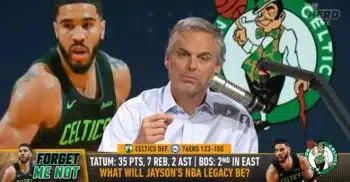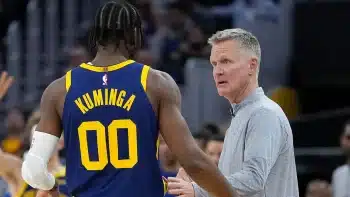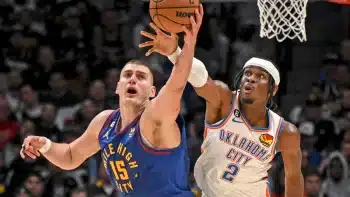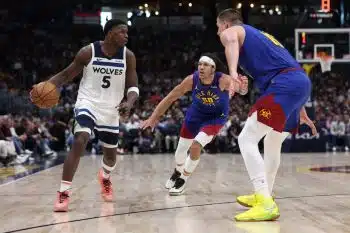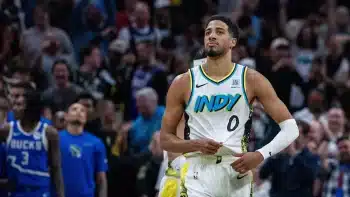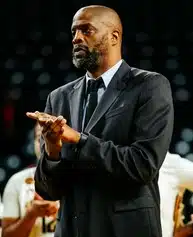NBA
NBA AM: Why The NBA Wants A New Age Limit
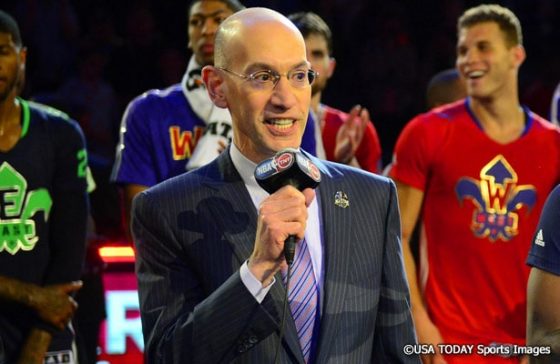
Some Thoughts On The Age Limit: By now you have likely heard that new NBA Commissioner Adam Silver wants to push through some changes to the NBA Draft eligibility process. Asked recently at the MIT Sloan Analytics Conference in Boston if there was one thing he could change in the NBA with the complete support of the owners and the players, Silver labeled increasing the age limit to enter the NBA as his top item.
Before we dig into the subject, there are a couple of things to know: The NBA currently requires a player to be 19 years of age (or turn 19 in the year he is drafted) and one year removed from his graduating class in high school. This is commonly referred to a “one-and-done” as it lends itself to players going to college for one year and then leaving for the NBA.
During the last round of collective bargaining talks between the players and the owners, the age limit was an intense topic of discussions. As the talks lead to a player lockout and in the interest of getting the lockout lifted both sides agreed that they would revisit the age limit and the draft at a later date and then the Players’ Association imploded amid scandal and those tabled talked never resumed.
One of Silvers’ top objectives this summer is to get those talks going, whether the Players’ Association is ready or not.
There are a few things to know about the logic of the age limit and why the NBA wants to increase it:
It’s Not About Ability To Play
The first rebuttal to the age limit discussion almost always surrounds ability to play. The NBA age restrictions are not about on-court ability, rather off-the-court ability. The 48-minutes of game action you see on the court are only the smallest fraction of what a NBA player goes through in a day. There are demands and responsibilities placed on professional athletes that younger players struggle with.
No one can argue that Kobe Bryant, Dwight Howard, Kevin Garnett and LeBron James who all turned out to be great hall-of-fame caliber players, couldn’t play in the NBA. That’s not the question. The question is would those players have become more marketable stars after a year or two in college?
Equally for every James there is a Gerald Green or a Korleone Young or a Ndudi Ebi. All three players had the skill and ability to play in the NBA, but all three struggled in their own way to become true professionals in the sport.
The current age limit was aimed at helping remove the fail rate, not only for the teams that drafted them, but for the players themselves.
In the ‘straight from high school’ era of the NBA, there was rampant corruption and manipulation of high school players who were incentivized to choose high exposure AAU tournaments over real development or structure. As a result an entire generation of players came into the NBA that struggled with being coached, the rigors of practice and professionalism. Those players excelled on the court but often struggled with integrating into a team environment and in the end that became problematic for the NBA.
The “one-and-done” rule has helped, which is why the belief that going to a “two-and-through” rule would be better.
»In Related: The Modern History of The NBA Draft By Pick.
The idea of a new, tougher age limit is not at all about a player’s ability to play the game. It’s about making sure that the players coming into the league are ready to be part of a team and that they have the life skills and maturity to overcome some of the obstacles that have claimed player’s careers.
From a self-preservation point of view, the NBA wants to ensure that its players do not fail and giving teams and players a larger window to understand what it takes to be successful is something Commissioner Silver feels has to change.
A Healthy College System Helps Everyone
Whether you like the idea or not, the NBA believes it is the caretaker of basketball. They have the funding, the star players and the resources to influence the game in ways almost no other single entity can.
To that end there is has been a long standing commitment from the NBA to make the game better and more accessible. The NBA spends millions on international basketball, on grass roots basketball and in support of college basketball through its funding of Team USA.
The NBA wants to improve the college game. Having players that have had more development time, coaching and exposure is good for the NBA. Having players enter the NBA slightly more polished and marketable is a good thing.
Commissioner Silver said he believes the NBA should have an advisory relationship with college basketball and said as part of a new higher age limit that maybe the NBA providing insurance and medical coverage options for players in college might be something the NBA would look at.
One idea that Silver admitted to liking was the idea of a player being able to be drafted by a NBA team, but being allowed to return to college. Currently NCAA rules prohibit a player from being eligible for college basketball if they are drafted.
It is common place in international circles that a player could enter the draft, be drafted and return to the international game until they feel they are ready for the NBA.
The NBA wants a healthy and successful college system and seems open to providing support and funding to make college better.
A “two-and-through” rule would surely benefit college basketball, but in Silver’s mind it would improve basketball in general on many fronts.
Teams Are Paying Millions On Players That Don’t Play
Outside of the maturity and social issues of drafting young players, there is an economic side too. Look down the roster of any team in the league and count how many players play little to no minutes but have large guaranteed contracts.
NBA teams are no longer drafting players that can contribute on day one. In fact, a lot of times they are drafting knowing full well a player can’t contribute in the first year at all. They are drafting players they know will need a year or two of development time and as a result veteran players that can help a team today are being hedged out in favor of guaranteed roster spots going to players that spend more time in the development process than on the floor.
Remove the teams that are clearly rebuilding this year, and look at the salary number of players that sometimes do not dress. There is a lot of money being paid to players in the NBA that do not play. Clearly that’s a team choice, but the system in place makes that choice somewhat difficult for teams trying to win now.
Some of this is on the teams for drafting them, but it’s also about the fact that so many drafted players have NBA ability, but not refined NBA skills. An additional year of college may or may not improve that, but the belief is more time in college will allow teams to scout and scrutinize players more and allow the players more time to development themselves both physically and mentally for what an 82-game season means in the NBA.
For some time there has been a lot of discussion in the NBA about making sure that the dollars spent on players is being spent on players who can play and contribute as professionals today.
The NBA’s Development League was supposed to help in this department. With the addition of an extra year needed before being NBA draft eligible there is some talk that maybe the D-League would be used more by up and coming players as a means to help them transition to the NBA more quickly.
The D-League currently allows players to enter the league right out of high school, so there are alternatives to college for those players that want to be paid to play.
As part of a compromise on an age limit, increasing the salary cap and funding of the D-League might be a reasonable trade off from the Players’ Association. Currently the D-League offers three salary slots for incoming players that range from $24,000, $21,000 and $19,000 per season. Increasing what a player can earn in the D-League might strengthen the D-League’s appeal and become a real alternative to college basketball for those players that genuinely don’t want to be college players.
Being Able To Market Your Rookies
The NBA is a business. You can never lose sight of that, especially when you are talking about broad process changes. Changing the age limit in the NBA is about business too; specifically the ability to market and promote its players and in turn convert that marketing into sales: season ticket sales, jersey sales and sponsorship sales.
The Sacramento Kings traded for college stud Jimmer Fredette, who was drafted with the 10th overall pick in the 2011 NBA Draft. There were far better prospects on the board at #10, but Fredette’s appeal as a known commodity and a personality that could be sold, found him drafted significantly higher than maybe his basketball talents justified.
NBA teams want to be able to market their young players. They want their fans to know and understand their draft day additions. Orlando Magic fans were excited to get Victor Oladipo this past summer. He was a known commodity and it was easy for them to get excited. If you rewind to last year’s pre-draft hype the names fans talked about were Trey Burke, Victor Oladipo and Ben McLemore. They were the stars of college basketball. They were known commodities. There wasn’t a lot of hype surrounding Kentavious Caldwell-Pope or Tony Snell, because they were not huge national TV darlings in college.
»In Related:The History Of The Draft By Team.
Having guys play on a bigger stage for a longer period of time not only increases their probability for success on the court in the NBA, it increases their value off the court for the teams that draft them.
Giannis Antetokounmpo has been a great addition to the Milwaukee Bucks, but on draft night most Bucks fans couldn’t pronounce his name, let alone describe his game.
Increasing the age limit isn’t going to solve all of the problems surrounding unknown talent, but increasing the age limit will likely improve marketability for more players than not.
Thinking Big Picture
The age limit is also about the big picture. There is a social statement that says the NBA is a multi-billion dollar profession that requires maturity to be successful. How many teams are three years away because the bulk of their roster is 21 years or younger? There is a professional statement that says you have to learn to play the game before you come to the NBA. Not using your rookie scale contract as on-the-job training. There is the message to the fans that says we will draft more players that will have a chance to be successful.
The miss rates on draft picks, especially as of late, are extremely high. There are 11 players from the first round of the 2011 NBA Draft that are no longer with the teams that held their rights on opening day in October of 2011. Of those 11 two are completely out of the NBA. Five of them did not have their rookie scale contract extended. The 2010 NBA Draft gets even worse. Seven players drafted with first round picks are no longer in the NBA.
The best way for a franchise to struggle to succeed is missing on first round draft picks. Teams that have sustained success tend to hit on more picks, especially late first round picks. Again some of that is on the teams and the executives making the decisions, but there is a real belief that the longer a players plays, the more you can learn about him both as a player and a person.
How differently does Oklahoma State’s Marcus Smart look as a NBA prospect today, after two years of college basketball scrutiny than he did after one season of college basketball?
You may not agree with the concept of an age limit in basketball, but when you hear the conversation about it understand that it’s really not a discussion about ability to play. It’s about making sure that the NBA is giving players a chance to be successful. The belief, right or wrong, is that a more mature player will have a better opportunity to succeed, develop the tools needed to handle the burdens of being an athlete away from the court, be more open to coaching and structure and be able to do more with his fame.
A new, tougher age limit won’t solve all the NBA problems, especially not all their draft-related problems, but like all rules the broader scope of the change is about making the game better for the fans. Better for the teams and better for the players.
No one has a right to play in the NBA. The NBA choses very selectively who gets in and who does not. There are high paying jobs playing basketball all over the world. The NBA views itself as the elite of the elite and restrictions on entry are simply part of that process. Whether a kid wants to go to college or not is completely his choice, but it’s clear that the NBA is moving towards a 20-year old age limit in the NBA, so you might as well get used to the idea because its coming.
Demps Talks Pierre and The Future: The New Orleans Pelicans were supposed to be better than they have been this season. Some of it can be blamed on injuries, some of it on so many lineup combinations and some of it on personnel and coaching.
Pelicans General Manager Dell Demps sat down with Pelicans broadcaster Sean Kelley and covered a number of topics including the injury status of several Pelican players, what the team plans to do with D-League sanitation Pierre Jackson and a lot more. Here are some of the highlights.
“Coming into the season we knew we had a lot of new faces and we put in a lot of new parts. We wanted to see how they would gel together,” Demps said. “My thinking was, let’s see how the first 15-20 games, let’s see how this group looks and then Ryan (Anderson) breaks his toe so you don’t really get a true evaluation. Tyreke (Evans) comes in and doesn’t get to play in the preseason because of his ankle. Then we got the group together and we go on a stretch and we go 12-10. We are feeling pretty good. We are thinking like we are going to make some noise and then the next thing you know, the injury bug hits us. Ryan gets the injury then Jrue gets the injury and Jason (Smith) and Tyreke and then bam, you lose nine in a row.
“I thought we had just gotten right back in that mix and we are about to make a run and the injuries hit us. It has been unfortunate. I still want to see this group play together. I believe in this group and we still want to add more pieces to this group. I think we are a fun group to watch. We are explosive. We can score a lot of points and I think moving forward we want to add a couple more pieces on the perimeter and interior and improve our defense. I think we will be able to score with anyone in the league.”
The Pelicans have lost both forward Ryan Anderson (herniated disc) and guard Jrue Holiday (fractured shin) for the balance of the season. Their future going forward is still a little cloudy according to Demps.
“We are hoping by the end of the week to get a little more clarity on those guys,” Demps said. “They are tough injuries, one with a tibia and the other with a herniated disc with Ryan. We have been getting some checkups. He has gone through some testing. He has done some light workouts, a little bit on the bicycle and treadmill kind of things. He has another test coming up at the end of this week and the same with Jrue. The tibia is a tough thing. It is one of those injuries where for the lay person I will say it is right on the shin and you are wondering has it healed. Will it heal? Do you need surgery? Those decisions we think will be made in the upcoming days.”
»In Related:The New Orleans Pelicans Team Salary.
Demps admits he received a ton of phone calls around the NBA trade deadline and holding firm wasn’t easy.
“Whenever you make a trade on the most part, you are trading an asset for an asset, a player for a player,” Demps said. “That is the first way of looking at it.
“If you trade a guard for a center or a small forward for a guard, on the most part you are keeping pretty even. Now every once and while there is going to be a trade where it is a home run where guys say ‘man he made this trade for this player for that player, how did that happen?’ But that’s rare.
“A second way of looking at it is, sometimes a team will give up an asset to acquire talent. A good example would be is that if you give up a draft pick and you might take on a player for that draft pick. Now you added talent and the other team added an asset for the future. A lot of times those things happen. I think for us at this trade deadline we were only looking to add to our core. We weren’t really looking to make any adjustments. We were looking to add. We didn’t want to give up any more assets to acquire any more players at this point. We did that last summer. We gave up a draft pick in this upcoming draft to acquire Jrue Holiday. We feel like Jrue Holiday is going to be our point guard for the future. We have him under contract for four years and we hope that he grows old here and his kids graduate from high school in New Orleans. We didn’t feel comfortable giving up any more assets for players at this time.”
One of the assets other teams were calling about was former Baylor guard Pierre Jackson, who the Pelicans hold the draft right to.
“Pierre is a player that we acquired on draft day last year. The kid had some bad luck to start with,” Demps said. “When we acquired him, we were stacked at the point guard position. Before we drafted him, we had conversations with him asking, ‘If we did draft you, we don’t know where you would fit on this year’s roster. Would you want to go overseas?’ He said yes.
“When we drafted him, we asked him to play summer league, but because of the trade he wasn’t cleared to play summer league until the third game. He didn’t get to come to the practices. Some guys had practiced for four or five days and they had a couple of games. We kind of just threw him into the fire. Then he catches pink eye, so he misses the next two days recovering from that and he comes back for the last game. He didn’t get a good opportunity to show what he could do. Like I said, our roster was filled at the time with guards, so he would end up going overseas, got homesick, came home, went to the D-league, and has played great. He’s had a number of 40-point games and even a 58-point game. We’ve been monitoring. I’ve even watch him play. We’ve sent some of our scouts and management personnel to watch him as well. We’ve been in constant communication with his representatives and with Pierre. Recently, he just signed a deal to go to one of the top teams in Europe. He’s going to go play for a team named Fenerbahçe in Turkey, which is arguably one of the top five teams in Europe. He’s already left; he’s in Turkey right now. We will continue to monitor him over there. Our plan moving forward with him is that he plans to play summer league with us this summer. I think that as we’re putting our roster together, we’ll get a true evaluation of where he fits in with us.”
The Pelicans traded their first round pick, top five protected, to the Philadelphia 76ers to obtain Jrue Holiday, so the plan all along was for Jackson to possibly be that kind of talent infusion for the team next season.
“When we talked to him last year about going overseas for a year, that was the plan, “ Demps said. “(It was), ‘Hey, we’re not going to have a draft pick next year to draft. He’s going to be our draft pick.’ He’s still a young player, you love his story. Coming out of high school not highly recruited, goes to junior college, plays great in junior college, goes to Baylor. I still remember the first time I saw him play. I went to watch a number of players at Baylor – they had four potential first round picks on their roster. I remember walking out of the practice and saying that he was the best player on the floor. Going to a couple of games, I kept saying he was the best player on the floor. He ended up being the Big 12 player of the year, leading the league in scoring and assists. He’s done a magnificent job of, every place he’s gone, he’s played well and his teams have won.”
The Pelicans are currently 26-37 on the season and a full 11 games out of the playoff picture in the west with 19 games left on the schedule. While not technically eliminated from the post-season, their odds of reaching the eight seed are astronomically low. So the balance of the season in New Orleans will be about development time and their younger guys on the roster.
»In Related:The 2014-2015 NBA Free Agents.
The Pelicans have $54.08 million in guaranteed salary commitments next season and are looking at roughly $8 million in useable cap space. The Pelicans do have a couple of key free agents which likely will bite into that number including forwards Al-Farouq Aminu and Jason Smith as well as center Greg Stiemsma.
More Twitter: Make sure you are following all of our guys on Twitter to ensure you are getting the very latest from our team: @stevekylerNBA, @AlexKennedyNBA, @TheRocketGuy, @LangGreene, @EricPincus, @joelbrigham, @SusanBible @TommyBeer, @JabariDavisNBA , @NateDuncanNBA , @MokeHamilton , @JCameratoNBA and @YannisNBA.
